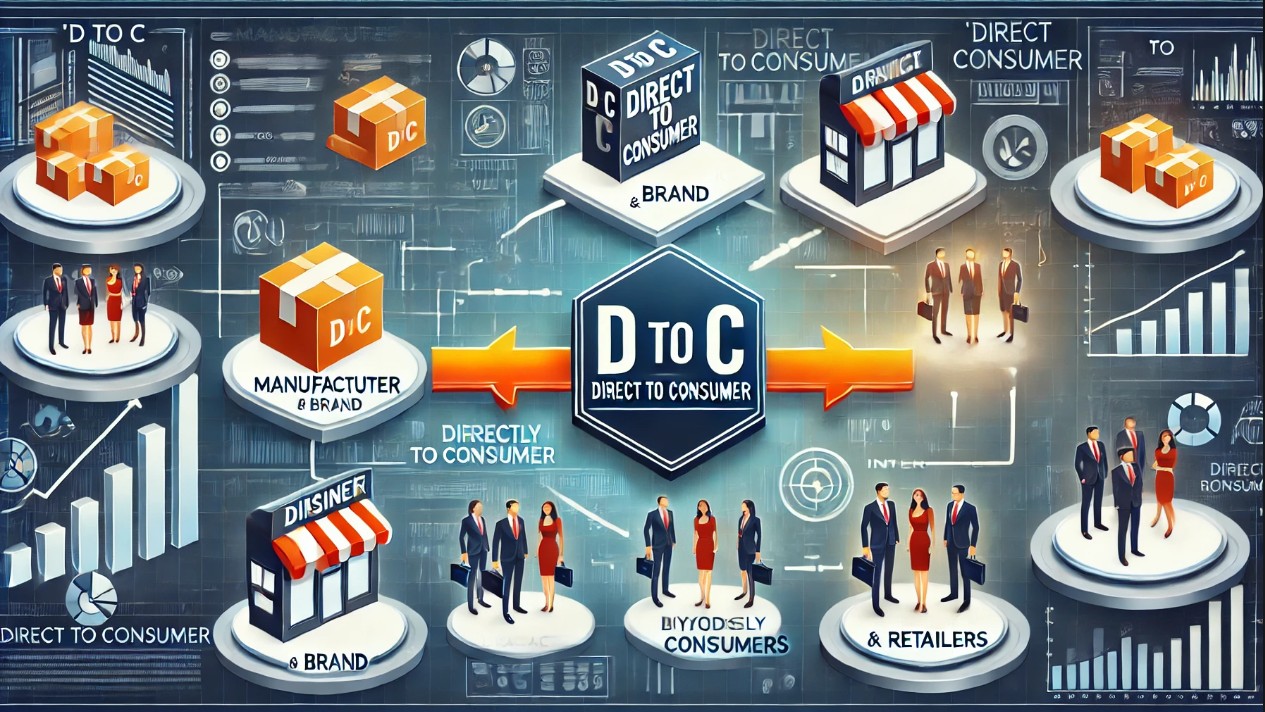In today’s digital economy, businesses are increasingly shifting towards direct-to-consumer (D2C) models, bypassing traditional retail channels and selling directly to their customers.
But what does D to C mean in business, and why is it gaining popularity?
Unlike traditional business-to-consumer (B2C) models, where products go through wholesalers and retailers before reaching customers, D2C brands eliminate middlemen, giving them complete control over branding, pricing, and customer relationships.
This approach not only increases profit margins but also allows for personalised shopping experiences, direct feedback loops, and stronger brand loyalty.
With the rise of e-commerce, social media marketing, and AI-driven customer insights, more brands are choosing D2C as their primary business model.
From subscription-based services like Dollar Shave Club to fashion giants like Gymshark, the D2C revolution is transforming the way businesses operate.
In this article, we’ll explore what D2C means in business, how it compares to other models, its benefits and challenges, and how companies can succeed with this approach.
Whether you’re a startup looking to enter the D2C market or an established brand considering this shift, understanding the D2C landscape is crucial for future growth.
What Does D to C Mean in Business?
The Direct-to-Consumer (D2C or DTC) business model is a retail approach where companies sell products directly to consumers without relying on third-party retailers, wholesalers, or middlemen.
This model allows brands to control their entire supply chain, marketing, and customer experience.
Unlike traditional retail, where manufacturers sell to distributors or retailers before reaching consumers, D2C businesses connect directly with their audience, often through e-commerce platforms.
This model has gained traction with the rise of digital marketing, social media, and online shopping trends.
What Are the Key Features of a D2C Business?
A D2C business typically possesses the following key characteristics:
- Direct Sales Channel: Products are sold directly through brand-owned websites, apps, or pop-up stores rather than third-party marketplaces.
- Customer Relationship Control: Companies engage with customers directly, gathering valuable data to improve marketing and personalisation.
- Brand Identity & Storytelling: Strong brand presence and storytelling play a crucial role in attracting and retaining customers.
- Data-Driven Decision Making: Analytics and customer insights help optimise sales strategies, product development, and personalised advertising.
- Digital-First Approach: Most D2C brands operate primarily online, leveraging digital tools such as social media, email marketing, and influencer partnerships.
How Does D2C Compare to Other Business Models?

The Direct-to-Consumer (D2C) model stands apart from traditional business approaches, offering brands more control over their operations, customer interactions, and profit margins. Here’s how D2C compares to other common business models:
D2C vs B2C (Business-to-Consumer)
The Business-to-Consumer (B2C) model typically involves companies selling their products through third-party retailers, such as supermarkets, department stores, or online marketplaces like Amazon.
In contrast, D2C brands eliminate intermediaries and sell directly to customers, allowing them to control pricing, branding, and customer experience.
Key Differences:
| Aspect | D2C Business Model | B2C Business Model |
| Sales Channel | Direct (website, social media, owned stores) | Indirect (retailers, marketplaces) |
| Brand Control | Full control over branding and pricing | Limited control due to third-party involvement |
| Customer Data | Direct access to consumer insights | Retailers control customer data |
| Profit Margins | Higher (no middlemen) | Lower (retailers take a cut) |
D2C vs B2B (Business-to-Business)
A Business-to-Business (B2B) model focuses on selling products or services to other companies rather than end consumers. B2B transactions are often bulk orders with longer sales cycles, whereas D2C involves direct engagement with individual customers.
Key Differences:
| Aspect | D2C Business Model | B2B Business Model |
| Target Audience | End consumers | Businesses, wholesalers |
| Sales Process | Shorter, impulse-driven | Longer, negotiation-based |
| Marketing Strategy | Digital marketing, influencer campaigns | Relationship-driven, corporate outreach |
D2C vs Wholesale & Retail
Traditional wholesale and retail models involve multiple layers between the manufacturer and the consumer. Wholesalers purchase large quantities from manufacturers and distribute them to retailers, who then sell to customers.
D2C bypasses both wholesalers and retailers, offering a more streamlined and cost-effective approach.
What Are the Benefits of a D2C Business Model?
- Higher Profit Margins: Since D2C brands eliminate intermediaries, they can sell products at competitive prices while keeping a larger share of the revenue. This is particularly beneficial for premium or niche brands looking to maximise profitability.
- Greater Control Over Branding & Customer Experience: Unlike selling through retailers, D2C businesses own their brand image, messaging, and product presentation. This allows for more consistent storytelling and direct engagement with customers.
- Direct Customer Relationships & Data Collection: By interacting directly with customers, D2C brands collect valuable first-party data, which can be used for targeted marketing, personalised shopping experiences, and product development.
- Faster Market Adaptation: With direct feedback loops, D2C businesses can quickly adjust their product offerings based on consumer demand, market trends, and real-time data analytics.
What Challenges Do D2C Businesses Face?

- High Customer Acquisition Costs: Without traditional retail exposure, D2C brands must invest heavily in digital marketing, paid ads, and influencer collaborations to drive traffic to their website. Acquiring customers can be expensive, especially in a saturated market.
- Logistics & Fulfilment Complexities: Handling inventory, packaging, shipping, and returns can be challenging for D2C brands. Unlike retailers with established distribution networks, D2C businesses must optimise their supply chain to ensure smooth operations.
- Building Trust & Brand Awareness: New D2C brands compete with well-established companies, requiring them to invest in branding, credibility, and community-building efforts.
How Can You Build a Successful D2C Business?

Creating a Strong Online Presence
- A well-designed, user-friendly website is the foundation of a successful D2C business. Investing in SEO, intuitive navigation, and mobile responsiveness enhances customer engagement.
Leveraging Social Media & Digital Marketing
Platforms like Instagram, TikTok, and Facebook are essential for:
- Brand awareness through influencer partnerships
- Targeted advertising to reach specific customer segments
- Engagement-driven content (videos, user-generated content, reviews)
Streamlining Supply Chain & Fulfilment
D2C brands must invest in:
- Reliable logistics partners for fast shipping
- Efficient inventory management systems
- Seamless return & exchange policies
Enhancing Customer Experience & Retention
- Offering personalised recommendations, excellent customer support, and loyalty programmes can significantly increase repeat purchases and customer lifetime value (CLV).
What Are Some Examples of Successful D2C Brands?

- Warby Parker: This eyewear brand disrupted the optical industry by selling stylish, affordable glasses directly to consumers with a home try-on service.
- Gymshark: A UK-based fitness apparel company that leveraged social media marketing and influencer collaborations to build a global community of fitness enthusiasts.
- Dollar Shave Club: This subscription-based razor company successfully used viral video marketing to challenge established brands like Gillette.
- Glossier: A beauty brand that built a loyal community through customer feedback, social media storytelling, and a digital-first approach.
How Is Technology Transforming the D2C Industry?

AI and Automation in D2C Businesses
- Chatbots for customer service provide instant responses to queries.
- AI-driven product recommendations enhance personalisation.
Role of Data Analytics and Customer Insights
- Brands use real-time analytics to track customer preferences.
- Predictive analytics helps brands optimise inventory and marketing strategies.
Growth of Mobile Commerce
With most consumers shopping via smartphones, D2C brands focus on:
- Mobile-friendly websites
- App-based loyalty programmes
- One-click checkout solutions
Why Is Customer Experience Crucial in D2C?

Importance of Personalisation
D2C brands leverage data to offer personalised:
- Product recommendations
- Email campaigns
- Exclusive discounts
Customer Service and Support Strategies
To build trust and retain customers, D2C brands focus on:
- 24/7 live chat and chatbot support
- Hassle-free returns and exchanges
- Engaging social media interactions
Retention Through Loyalty Programmes
D2C brands offer:
- Membership-based discounts
- Point-based rewards systems
- Exclusive early access to new products
Conclusion
The Direct-to-Consumer (D2C) business model is reshaping the way brands interact with customers. By eliminating intermediaries, businesses gain more control over pricing, marketing, and customer relationships.
However, success in the D2C space requires strategic digital marketing, strong brand storytelling, and seamless logistics. As technology continues to evolve, the future of D2C looks promising, offering brands new opportunities for growth and innovation.
FAQs
What is the main difference between D2C and B2C?
D2C brands sell directly to consumers without intermediaries, while B2C companies often rely on third-party retailers to distribute products.
Can a small business succeed with a D2C model?
Yes, many small businesses have successfully built D2C brands by leveraging digital marketing, social media, and e-commerce platforms.
What are the common challenges faced by D2C brands?
Common challenges include high customer acquisition costs, logistics and fulfilment complexities, and the need to build brand trust.
How does D2C impact traditional retail businesses?
D2C brands disrupt traditional retail by offering direct access to customers, reducing reliance on physical stores, and often providing competitive pricing.
Is D2C only relevant for e-commerce businesses?
While D2C is primarily an online model, some brands integrate physical retail spaces through pop-up shops or flagship stores.
What strategies can help a D2C brand grow?
Effective strategies include digital marketing, strong brand storytelling, data-driven decision-making, and exceptional customer service.
How do D2C businesses handle logistics and fulfilment?
Many D2C brands invest in efficient warehousing, third-party logistics (3PL) services, and automated order processing to ensure smooth fulfilment.




